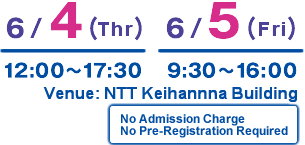
Director's Talk
Thursday, June 4 13:00-13:30
Embracing information science and technology
- Decoding, exploring and designing of the world -
Eisaku Maeda, Vice President, Head of
NTT Communication Science Laboratories
Abstract
An era in which human beings face off against “machines” (computers or artificial intelligence) is coming to an end. From here on, we will embrace information science and technology as part of ourselves. This will necessitate the ability to decode, explore, and design the entire world, including us human beings. While bearing in mind the drastic changes in the information environment that we have experienced in the first fifteen years of the twenty-first century, we must think about what should make up basic research that will form the compass of the future as we envision the year 2030, fifteen years from now. In this address, I would like to discuss three aspects that may serve as possible turning points of our history.
From Measuring to Understanding
The first turning point is a transition from an era in which physical amounts of the real world are measured by sensors to an era in which diverse information flows through two types of space-time ? the real world and the virtual world ? and are decoded. Sound-recording microphones will be replaced by microchips that decode the audio environment. Such a development will be equivalent to the evolution of human beings’ audiovisual processing system, which includes the sensory organs like ears and eyes and the frontal lobe of cerebral cortex. The growing intelligence of sensor devices that continue to evolve in the real world can be said to be origin of turning point I just described. A similar evolution is happening in the virtual world. This development will necessitate new security technologies.
From Analysis to Exploration
Second, we will transition from an era of analysis in which massively gathered data are analyzed with statistical techniques to an era of exploration in which the conclusion necessary for control or decision-making can be immediately acquired.
There are two major features to exploration in the age of Big Data. The first is returning an exploratory result with a probability value attached. The second is that making possible fast yet inexpensive exploration. This will be the key to the new age. With the arrival of Big Data, an empirical element is being added to the academic discipline that is information science. The two points I mentioned are similar to the key of improving productivity through assay (screening) in the experimental sciences and manufacturing science.
There are two major features to exploration in the age of Big Data. The first is returning an exploratory result with a probability value attached. The second is that making possible fast yet inexpensive exploration. This will be the key to the new age. With the arrival of Big Data, an empirical element is being added to the academic discipline that is information science. The two points I mentioned are similar to the key of improving productivity through assay (screening) in the experimental sciences and manufacturing science.
From Implementation to Design
The third aspect is the move from an age of implementation in which information processing technologies in the form of machines are actuated in the real world, to an age in which design is optimized for the overall system which connects both the real world and the virtual world into a Cyber Physical System (CPS). Because the enterprise to design the overall world is itself an application of decoding, recursive methods will expand understanding of the world outward in a spiral. The research we are tackling right now can be placed in the flow of decoding, exploring, and designing the world.
[Related references]
- [1] Eisaku Maeda, “Basic research - Defining our age and the future, - The origin of ideas and the seeds of innovation -” , NTT Communication Science Laboratories Open House 2014 Director’s Address, June, 5, 2014. (https://www.rd.ntt/cs/event/openhouse/2014/talk/director/index_en.html)
- [2] Eisaku Maeda, “The Evolution of Basic Research,” NTT Technical Review, Vol. 12, No. 11,, 2014. (https://www.ntt-review.jp/archive/2014/201411.html)
- [3] Eisaku Maeda, “The Enchantment of Turning toward Academics (in Japanese),” Journal of Information and System Society (Institute of Electronics, Information and Communication Engineers), Vol. 19, No.2, pp. 21-22, 2014.
Photos
Speaker

Eisaku Maeda
Vice President, Head of NTT Communication Science Laboratories 

